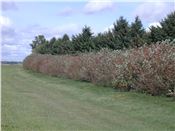Windbreaks Can Help Prevent Herbicide Injury

A multiple-row windbreak consisting of conifers and densly growing deducious shrubs.
University of Nebraska
MICHELE WARMUND
COLUMBIA, MISSOURI
Plant injury due to the off-target movement of herbicides such as dicamba and 2,4-D is one of the challenges to the production of specialty crops.
“There are few short-term solutions to avoid plant damage when herbicides drift onto property other than growing plants in protective structures or planting crops and cultivars that are less susceptible to herbicide injury,” says University of Missouri Extension horticulturist Michele Warmund.
For long-term mitigation of herbicide drift injury, consider erecting a permanent fence of wood or some other material, such as heavy-duty woven landscape fabric or construction-grade geotextile fabric. But this can be relatively expensive for large properties and might only protect low-growing vegetables and small fruit plants, says Warmund.
Another solution is a living windbreak using closely-spaced plants on the perimeter of the property. Sorghum-Sudan grass is an annual plant that grows 5 to 12 feet tall. Multiple rows can provide an inexpensive annual barrier to protect low-growing crops against herbicide drift.
In Missouri, Sorghum-Sudan grass is usually planted after May 1 or when the soil temperature is above 60 F.
Another option is a windbreak consisting of multiple rows of perennial trees and shrubs. In a three-row windbreak, one row of evergreen trees, a second row of shrubs and a third staggered row of shrubs in a planting about 40-50 feet wide will provide greater protection against herbicide drift than one with fewer rows. However, even a single row of tall plants with dense foliage will help minimize damage, she says.
When choosing plant materials, consider suitability to the climate, soil, capacity for fast growth and potential height and density. Avoid windbreak plants that harbor pests that can harm specialty crops.
Plant shrubs 3 to 8 feet apart in a row; small, thicket-forming trees about 8 to 15 feet apart; and large conifers 25 to 30 feet apart.
Plant trees and shrubs at closer spacings. Later, when they become crowded, remove every other one. In either case, space plants closer together than those in a home landscape, since any gaps in the windbreak become funnels that concentrate airflow and accelerate wind speed.
Some trees and shrubs suitable for this type of windbreak include American plum, silky or red twig dogwood, witch hazel, ninebark and American filbert. Another is shortleaf loblolly pine, a fast-growing evergreen. Eastern red cedar and arborvitae are two other evergreens that may be at some sites. Nurseries that specialize in native trees and shrubs offer these plants, but place orders at least six months in advance to ensure availability, says Warmund.
In Missouri, prevailing winds are from the north and northwest, but drift can be multidirectional, and auxin herbicides are known to move great distances. Therefore, it’s best to plant a windbreak that will enclose the property or planting, if possible, says Warmund. One of the drawbacks of windbreaks of trees and shrubs is that it takes more than one growing season to produce a solid wall of vegetation to mitigate drift. In addition, purchasing trees and shrubs of any size is expensive.
There are government programs available to help purchase and maintain windbreaks for drift mitigation on farm property, says Warmund. The first step is to obtain a farm and tract number from your local Farm Service Agency. Next, visit your local Natural Resources Conservation Service (NRCS) office to apply for funding from the Environmental Quality Incentives Program (EQIP). In addition to the EQIP application, a conservation plan is required.
These documents usually have a fall deadline, but Warmund encourages early submission. Funding is competitive and applications are ranked by priority. Under EQIP, growers usually pay upfront costs with their own funds and receive reimbursement after the windbreak is certificated as meeting NRCS standards. However, a participant can opt for the advance payment option. NRCS offices have personnel to assist with the application process and windbreak planning. ∆
MICHELE WARMUND: University of Missouri